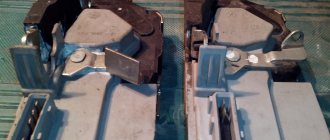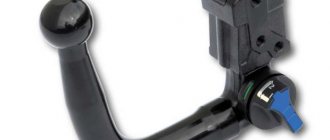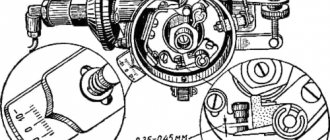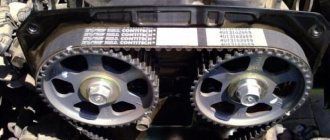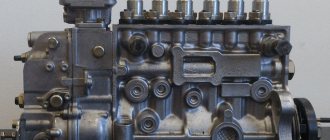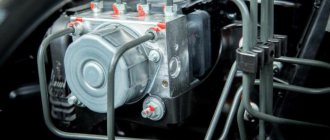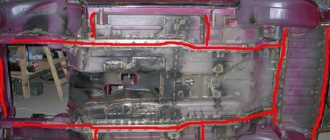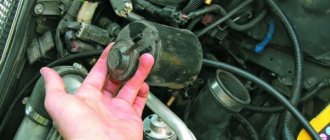Hello everyone, today I’ll tell you about the timing belt, many drivers don’t even know what it is and where it is located. Even if you know what a timing belt is, it is important to understand what problems arise if it breaks! Problems can only be avoided by replacing it in a timely manner. After a break, the valves usually break and the motor stops working, and the cost of repairing the motor is much higher, and the repair takes much longer.
What is a timing belt in a car?
In a car, the timing belt is an element shaped like a closed ring. The part is made of technical rubber. The internal part is reinforced with synthetic fibers, which prevent the element from stretching and increase the rigidity of the product. The outside of the belt is smooth, and the inside has teeth.
This element is also called a drive belt. Each engine has its own dimensions and is therefore equipped with a belt of a specific diameter. There are also cars that use a chain instead of a rubber belt. A separate review describes car models that have this type of drive.
In the 1950s, many cars used a chain, but this type of timing drive was very noisy and also heavy. For its operation you need a damper and a tension shoe. These elements made the engine design more complex and heavy, which affected the dynamic characteristics of the vehicle.
When automakers tried to replace chain drives with belt drives, motorists were initially not very enthusiastic about it. But over time, the timing belt proved its practicality: the engine became less noisy, simpler and cheaper to maintain.
To understand what a belt is intended for, you must first understand what a timing belt is.
The timing belt is a gas distribution mechanism, which in most modern power units is installed in the cylinder head. It is designed for the correct distribution of phases (intake/exhaust) in each engine cylinder. More details about what valve timing is can be found in another review . This mechanism opens and closes the intake and exhaust valves using the camshaft (read about the configurations and function of this part here ).
There are 3 modifications of these mechanisms. They differ from each other in the location of the camshaft and valves. Here are the types of drives:
- The valves are located in the cylinder head, and the camshaft is at the bottom of the engine. In order for the valve timing to operate, the camshaft drives the valves through rocker arms and pusher rods. This modification of the timing belt does not allow the development of high crankshaft speeds, which is why the power of the internal combustion engine suffers.
- The valves are located at the bottom of the cylinder block with the plates facing up. In this case, the camshaft will also be located at the bottom of the engine, and the cams drive the valves themselves. Such engines have a very complex fuel system, which complicates the maintenance and repair of the unit.
- The most common type of timing mechanism with an overhead camshaft and valves (in the cylinder head). One camshaft can serve all valves or only the intake or exhaust valves. There are modifications in which the cams press on the rocker arms, as well as directly on the valves.
Regardless of what type of gas distribution mechanism is used in the engine, its principle of operation is the same - to open the corresponding valve in time when the piston performs an exhaust or intake stroke (what engine strokes are is described here ). The valve opening time also depends on the engine operating mode. Modern engines use a phase shifter.
If the gas distribution mechanism is not configured correctly, the engine will, at best, operate unstable. In the worst case, it will not function.
Video illustrating the operation of the timing belt
What else is worth reading
Muffler design
Operating principle of a diesel engine
Diesel engine fuel system design
What are seat belts for?
Where is the timing belt located in a car?
The timing belt is located on the opposite side of the flywheel (read what it is and what modifications there are here ). It fits onto the crankshaft and camshaft pulleys. They can be made in the form of wide gears or ordinary pulleys. In the first case, if the belt tension is weak, it will not slip, due to which the valve timing settings will be maintained.
The first belts were reinforced with metal courts, but more elastic modifications are those that contain synthetic fibers. Rubber ensures minimal noise of the part. Regardless of the design of the motor drive pulleys, the belt must have teeth, which ensures the best adhesion to the contact surface of the parts.
In addition to being installed on the camshaft and crankshaft, the belt also connects other attachments to the unit, such as a pump. The remaining mechanisms are connected to the motor using their own belts.
Structurally, it would be easier to connect all the mechanisms with one belt, but this will significantly reduce the service life of this element. Regardless of the type of engine, automakers have made access to the belt as easy as possible to make it easier to check and replace.
Each car model has its own timing belt, since the design of the engines is different. In each individual case, the diameter of the ring will be different. To ensure maximum strength of fixation of this element on the pulleys, it is tensioned using a special roller (often sold complete with a belt).
What is a gas distribution mechanism
So, timing belt, what is it in a car?
This is a kind of conductor that lets fuel in and releases gases.
Types of engine gas distribution mechanism 2:
- Valve mechanism. It is found more often in cars - in almost all 4-stroke engines - and is almost always located on top.
- Spool mechanism. Mainly installed on two-stroke motorcycle engines.
What is the timing belt used for?
Depending on the type of engine, an already prepared mixture of air and fuel, or only air (if the engine is equipped with direct injection), enters the cylinder through the valves. In order for each valve to open and close on time, the timing mechanism must be synchronized with the operation of the crankshaft .
